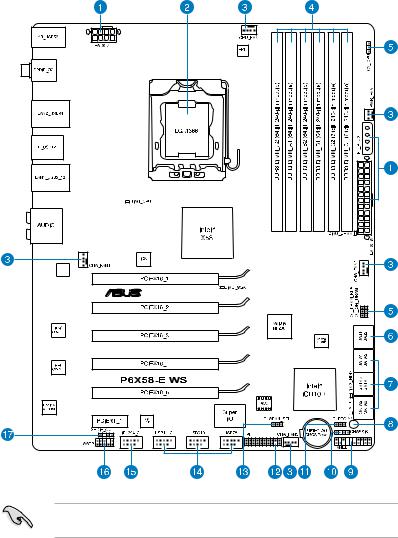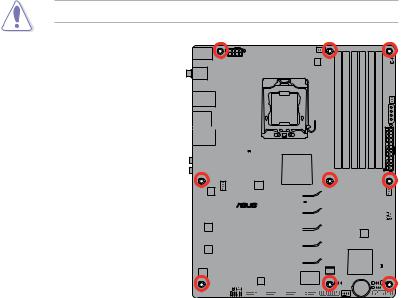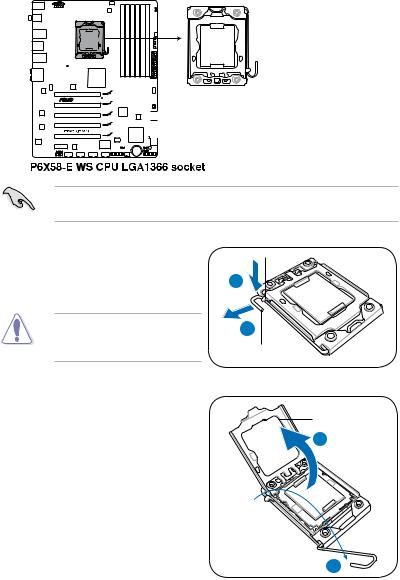ASUS P6X58-E WS User Manual

P6X58-E WS
Motherboard

E6383
First Edition
February 2011
Copyright © 2011 ASUSTeK COMPUTER INC. All Rights Reserved.
No part of this manual, including the products and software described in it, may be reproduced, transmitted, transcribed, stored in a retrieval system, or translated into any language in any form or by any means, except documentation kept by the purchaser for backup purposes, without the express written permission of ASUSTeK COMPUTER INC. (“ASUS”).
Product warranty or service will not be extended if: (1) the product is repaired, modified or altered, unless such repair, modification of alteration is authorized in writing byASUS; or (2) the serial number of the product is defaced or missing.
ASUS PROVIDES THIS MANUAL “AS IS” WITHOUT WARRANTY OF ANY KIND, EITHER EXPRESS OR IMPLIED, INCLUDING BUT NOT LIMITED TO THE IMPLIED WARRANTIES OR CONDITIONS OF MERCHANTABILITY OR FITNESS FOR A PARTICULAR PURPOSE. IN NO EVENT SHALL ASUS, ITS DIRECTORS, OFFICERS, EMPLOYEES OR AGENTS BE LIABLE FOR ANY INDIRECT, SPECIAL, INCIDENTAL, OR CONSEQUENTIAL DAMAGES (INCLUDING DAMAGES FOR LOSS OF PROFITS, LOSS OF BUSINESS, LOSS OF USE OR DATA, INTERRUPTION OF BUSINESS AND THE LIKE), EVEN IF ASUS HAS BEEN ADVISED OF THE POSSIBILITY OF SUCH DAMAGES ARISING FROM ANY DEFECT OR ERROR IN THIS MANUAL OR PRODUCT.
SPECIFICATIONS AND INFORMATION CONTAINED IN THIS MANUAL ARE FURNISHED FOR INFORMATIONAL USE ONLY, AND ARE SUBJECT TO CHANGE AT ANY TIME WITHOUT NOTICE, AND SHOULD NOT BE CONSTRUED AS A COMMITMENT BY ASUS. ASUS ASSUMES NO RESPONSIBILITY OR LIABILITY FOR ANY ERRORS OR INACCURACIES THAT MAY APPEAR IN THIS MANUAL, INCLUDING THE PRODUCTS AND SOFTWARE DESCRIBED IN IT.
Products and corporate names appearing in this manual may or may not be registered trademarks or copyrights of their respective companies, and are used only for identification or explanation and to the owners’ benefit, without intent to infringe.
ii

Contents
Notices....................................................................................................... |
viii |
Safety information....................................................................................... |
ix |
About this guide........................................................................................... |
x |
P6X58-E WS specifications summary...................................................... |
xii |
Chapter 1: |
Product introduction |
|
|
1.1 |
Welcome!....................................................................................... |
1-1 |
|
1.2 |
Package contents......................................................................... |
1-1 |
|
1.3 |
Special features............................................................................ |
1-2 |
|
|
1.3.1 |
Product highlights............................................................ |
1-2 |
|
1.3.2 |
ASUS Unique features ................................................... |
1-3 |
Chapter 2: |
Hardware information |
|
|
2.1 |
Before you proceed...................................................................... |
2-1 |
|
2.2 |
Motherboard overview................................................................. |
2-2 |
|
|
2.2.1 |
Motherboard layout.......................................................... |
2-2 |
|
2.2.2 |
Layout contents............................................................... |
2-3 |
|
2.2.3 |
Placement direction......................................................... |
2-4 |
|
2.2.4 |
Screw holes..................................................................... |
2-4 |
2.3 |
Central Processing Unit (CPU).................................................... |
2-5 |
|
|
2.3.1 |
Installing the CPU............................................................ |
2-6 |
|
2.3.2 |
Installing the CPU heatsink and fan................................ |
2-9 |
|
2.3.3 |
Uninstalling the CPU heatsink and fan.......................... |
2-10 |
2.4 |
System memory.......................................................................... |
2-11 |
|
|
2.4.1 |
Overview......................................................................... |
2-11 |
|
2.4.2 |
Memory configurations.................................................. |
2-12 |
|
2.4.3 |
Installing a DIMM........................................................... |
2-13 |
|
2.4.4 |
Removing a DIMM......................................................... |
2-13 |
2.5 |
Expansion slots.......................................................................... |
2-18 |
|
|
2.5.1 |
Installing an expansion card.......................................... |
2-18 |
|
2.5.2 |
Configuring an expansion card...................................... |
2-18 |
|
2.5.3 |
Interrupt assignments.................................................... |
2-19 |
|
2.5.4 |
Expansion slots............................................................. |
2-20 |
2.6 |
Onboard LEDs............................................................................. |
2-22 |
|
2.7 |
Jumpers |
....................................................................................... |
2-23 |
iii

Contents
2.8 |
Connectors.................................................................................. |
2-26 |
|
|
2.8.1 |
Rear panel connectors.................................................. |
2-26 |
|
2.8.2 |
Audio I/O connections................................................... |
2-27 |
|
2.8.3 |
Internal connectors........................................................ |
2-30 |
2.9 |
G.P. Diagnosis card installation................................................ |
2-41 |
|
|
2.9.1 |
G.P. Diagnosis card layout............................................. |
2-41 |
|
2.9.2 |
Installing G.P. Diagnosis card........................................ |
2-41 |
|
2.9.3 |
G.P. Diagnosis card check codes.................................. |
2-42 |
2.10 |
Starting up for the first time...................................................... |
2-43 |
|
2.11 |
Turning off the computer........................................................... |
2-44 |
|
Chapter 3: |
BIOS setup |
|
|
3.1 |
Managing and updating your BIOS............................................. |
3-1 |
|
|
3.1.1 |
ASUS Update utility......................................................... |
3-1 |
|
3.1.2 |
ASUS EZ Flash 2 utility................................................... |
3-4 |
|
3.1.3 |
ASUS CrashFree BIOS 3 utility....................................... |
3-5 |
3.2 |
BIOS setup program..................................................................... |
3-6 |
|
|
3.2.1 |
BIOS menu screen.......................................................... |
3-7 |
|
3.2.2 |
Menu bar......................................................................... |
3-7 |
|
3.2.3 |
Navigation keys............................................................... |
3-7 |
|
3.2.4 |
Menu items...................................................................... |
3-8 |
|
3.2.5 |
Sub-menu items.............................................................. |
3-8 |
|
3.2.6 |
Configuration fields.......................................................... |
3-8 |
|
3.2.7 |
Pop-up window................................................................ |
3-8 |
|
3.2.8 |
Scroll bar......................................................................... |
3-8 |
|
3.2.9 |
General help.................................................................... |
3-8 |
3.3 |
Main menu..................................................................................... |
3-9 |
|
|
3.3.1 |
System Time [xx:xx:xx].................................................... |
3-9 |
|
3.3.2 |
System Date [Day xx/xx/xxxx]......................................... |
3-9 |
|
3.3.3 |
Language [English].......................................................... |
3-9 |
|
3.3.4 |
SATA 1-6........................................................................ |
3-10 |
|
3.3.5 |
Storage Configuration..................................................... |
3-11 |
|
3.3.6 |
AHCI Configuration........................................................ |
3-12 |
|
3.3.7 |
System Information........................................................ |
3-13 |
3.4 |
Ai Tweaker menu........................................................................ |
3-14 |
|
iv

Contents
|
3.4.1 |
Ai Overclock Tuner [Auto].............................................. |
3-15 |
|
3.4.2 |
CPU Ratio Setting [Auto]............................................... |
3-15 |
|
3.4.3 |
Intel(R) SpeedStep(TM) Tech [Enabled]........................ |
3-15 |
|
3.4.4 |
Intel(R) Turbo Mode Tech [Enabled].............................. |
3-15 |
|
3.4.5 |
High TDP Turbo Mode [Auto]......................................... |
3-16 |
|
3.4.6 |
BCLK Frequency [XXX]................................................. |
3-16 |
|
3.4.7 |
PCIE Frequency [XXX].................................................. |
3-16 |
|
3.4.8 |
DRAM Frequency [Auto]................................................ |
3-16 |
|
3.4.9 |
UCLK Frequency [Auto]................................................. |
3-16 |
|
3.4.10 |
QPI Link Data Rate [Auto]............................................. |
3-16 |
|
3.4.11 |
DRAM Timing Control [Auto]......................................... |
3-17 |
|
3.4.12 |
CPU Voltage [Auto] ....................................................... |
3-17 |
|
3.4.13 |
CPU PLL Voltage [Auto]................................................ |
3-17 |
|
3.4.14 |
QPI/DRAM Core Voltage [Auto]..................................... |
3-17 |
|
3.4.15 |
IOH Voltage [Auto]......................................................... |
3-17 |
|
3.4.16 |
IOH PCIE Voltage [Auto]............................................... |
3-17 |
|
3.4.17 |
ICH Voltage [Auto]......................................................... |
3-18 |
|
3.4.18 |
ICH PCIE Voltage [Auto]................................................ |
3-18 |
|
3.4.19 |
DRAM Bus Voltage [Auto]............................................. |
3-18 |
|
3.4.20 |
DRAM DATA REF Voltage on CHA/B/C [Auto].............. |
3-19 |
|
3.4.21 |
DRAM CTRL REF Voltage on CHA/B/C [Auto].............. |
3-19 |
|
3.4.22 |
Load-Line Calibration [Auto].......................................... |
3-19 |
|
3.4.23 |
CPU Differential Amplitude [Auto].................................. |
3-19 |
|
3.4.24 |
CPU Clock Skew [Auto]................................................. |
3-19 |
|
3.4.25 |
CPU Spread Spectrum [Auto]........................................ |
3-19 |
|
3.4.26 |
IOH Clock Skew [Auto].................................................. |
3-19 |
|
3.4.27 |
PCIE Spread Spectrum [Auto]....................................... |
3-19 |
3.5 |
Advanced menu.......................................................................... |
3-20 |
|
|
3.5.1 |
CPU Configuration......................................................... |
3-20 |
|
3.5.2 |
Chipset.......................................................................... |
3-23 |
|
3.5.3 |
Onboard Device Configuration...................................... |
3-24 |
|
3.5.4 |
USB Configuration......................................................... |
3-26 |
|
3.5.5 |
PCIPnP.......................................................................... |
3-27 |
3.6 |
Power menu................................................................................ |
3-28 |
|

Contents
|
3.6.1 |
Suspend Mode [Auto].................................................... |
3-28 |
|
3.6.2 |
Repost Video on S3 Resume [No]................................. |
3-28 |
|
3.6.3 |
ACPI 2.0 Support [Disabled].......................................... |
3-28 |
|
3.6.4 |
ACPI APIC Support [Enabled]....................................... |
3-28 |
|
3.6.5 |
EuP Ready [Disabled].................................................... |
3-28 |
|
3.6.6 |
APM Configuration........................................................ |
3-29 |
|
3.6.7 |
Hardware Monitor.......................................................... |
3-30 |
3.7 |
Boot menu................................................................................... |
3-32 |
|
|
3.7.1 |
Boot Device Priority....................................................... |
3-32 |
|
3.7.2 |
Boot Settings Configuration........................................... |
3-33 |
|
3.7.3 |
Security.......................................................................... |
3-34 |
3.8 |
Tools menu.................................................................................. |
3-36 |
|
|
3.8.1 |
ASUS EZ Flash 2.......................................................... |
3-36 |
|
3.8.2 |
ASUS O.C. Profile......................................................... |
3-37 |
|
3.8.3 |
Drive Xpert Configuration.............................................. |
3-38 |
3.9 |
Exit menu..................................................................................... |
3-39 |
|
Chapter 4: |
Software support |
|
|
4.1 |
Installing an operating system.................................................... |
4-1 |
|
4.2 |
Support DVD information............................................................. |
4-1 |
|
|
4.2.1 |
Running the support DVD................................................ |
4-1 |
|
4.2.2 |
Obtaining the software manuals...................................... |
4-2 |
4.3 |
Software information.................................................................... |
4-3 |
|
|
4.3.1 |
AI Suite II......................................................................... |
4-3 |
|
4.3.2 |
TurboV EVO.................................................................... |
4-4 |
|
4.3.4 |
EPU................................................................................. |
4-6 |
|
4.3.5 |
FAN Xpert........................................................................ |
4-7 |
|
4.3.6 |
Probe II............................................................................ |
4-8 |
|
4.3.7 |
Sensor Recorder............................................................. |
4-9 |
|
4.3.9 |
Audio configurations...................................................... |
4-10 |
4.4 |
RAID configurations................................................................... |
4-12 |
|
|
4.4.1 |
RAID definitions............................................................. |
4-12 |
|
4.4.2 |
Installing Serial ATA hard disks...................................... |
4-13 |
|
4.4.3 |
Setting the RAID item in BIOS....................................... |
4-13 |
|
4.4.4 |
Intel® Matrix Storage Manager option ROM utility......... |
4-14 |
vi

Contents
|
4.4.5 |
Marvell RAID utility........................................................ |
4-18 |
4.5 |
Creating a RAID driver disk....................................................... |
4-22 |
|
|
4.5.1 |
Creating a RAID driver disk without entering the OS.... |
4-22 |
|
4.5.2 |
Creating a RAID driver disk in Windows®...................... |
4-22 |
|
4.5.3 |
Installing the RAID driver |
4-23 |
|
|
during Windows® OS installation................................... |
|
|
4.5.4 |
Using a USB floppy disk drive....................................... |
4-24 |
Chapter 5: |
Multiple GPU technology support |
|
|
5.1 |
ATI® CrossFireX™ technology..................................................... |
5-1 |
|
|
5.1.1 |
Requirements.................................................................. |
5-1 |
|
5.1.2 |
Before you begin............................................................. |
5-1 |
|
5.1.3 |
Installing CrossFireX graphics cards............................... |
5-2 |
|
5.1.4 |
Installing the device drivers............................................. |
5-3 |
|
5.1.5 |
Enabling the ATI® CrossFireX™ technology.................... |
5-3 |
5.2 |
NVIDIA® SLI™ technology............................................................ |
5-5 |
|
|
5.2.1 |
Requirements.................................................................. |
5-5 |
|
5.2.2 |
Installing two SLI-ready graphics cards........................... |
5-6 |
|
5.2.3 |
Installing three SLI-ready graphics cards........................ |
5-7 |
|
5.2.4 |
Installing the device drivers............................................. |
5-8 |
|
5.2.5 |
Enabling the NVIDIA® SLI™ technology.......................... |
5-8 |
vii

Notices
Federal Communications Commission Statement
This device complies with Part 15 of the FCC Rules. Operation is subject to the following two conditions:
•This device may not cause harmful interference, and
•This device must accept any interference received including interference that may cause undesired operation.
This equipment has been tested and found to comply with the limits for a Class B digital device, pursuant to Part 15 of the FCC Rules. These limits are designed to provide reasonable protection against harmful interference in a residential installation. This equipment generates, uses and can radiate radio
frequency energy and, if not installed and used in accordance with manufacturer’s instructions, may cause harmful interference to radio communications. However, there is no guarantee that interference will not occur in a particular installation. If this equipment does cause harmful interference to radio or television reception, which can be determined by turning the equipment off and on, the user is encouraged to try to correct the interference by one or more of the following measures:
•Reorient or relocate the receiving antenna.
•Increase the separation between the equipment and receiver.
•Connect the equipment to an outlet on a circuit different from that to which the receiver is connected.
•Consult the dealer or an experienced radio/TV technician for help.
The use of shielded cables for connection of the monitor to the graphics card is required to assure compliance with FCC regulations. Changes or modifications to this unit not expressly approved by the party responsible for compliance could void the user’s authority to operate this equipment.
Canadian Department of Communications Statement
This digital apparatus does not exceed the Class B limits for radio noise emissions from digital apparatus set out in the Radio Interference Regulations of the Canadian Department of Communications.
This class B digital apparatus complies with Canadian ICES-003.
REACH
Complying with the REACH (Registration, Evaluation,Authorization, and
Restriction of Chemicals) regulatory framework, we published the chemical substances in our products at ASUS website at http://csr.asus.com/english/ REACH.htm.
viii

Safety information
Electrical safety
•To prevent electrical shock hazard, disconnect the power cable from the electrical outlet before relocating the system.
•When adding or removing devices to or from the system, ensure that the power cables for the devices are unplugged before the signal cables are connected. If possible, disconnect all power cables from the existing system before you add a device.
•Before connecting or removing signal cables from the motherboard, ensure that all power cables are unplugged.
•Seek professional assistance before using an adapter or extension cord. These devices could interrupt the grounding circuit.
•Ensure that your power supply is set to the correct voltage in your area. If you are not sure about the voltage of the electrical outlet you are using, contact your local power company.
•If the power supply is broken, do not try to fix it by yourself. Contact a qualified service technician or your retailer.
Operation safety
•Before installing the motherboard and adding devices on it, carefully read all the manuals that came with the package.
•Before using the product, ensure all cables are correctly connected and the power cables are not damaged. If you detect any damage, contact your dealer immediately.
•To avoid short circuits, keep paper clips, screws, and staples away from connectors, slots, sockets and circuitry.
•Avoid dust, humidity, and temperature extremes. Do not place the product in any area where it may become wet.
•Place the product on a stable surface.
•If you encounter technical problems with the product, contact a qualified service technician or your retailer.
DO NOT throw the motherboard in municipal waste. This product has been designed to enable proper reuse of parts and recycling. This symbol of the crossed out wheeled bin indicates that the product (electrical and electronic equipment) should not be placed in municipal waste. Check local regulations for disposal of electronic products.
DO NOT throw the mercury-containing button cell battery in municipal waste. This symbol of the crossed out wheeled bin indicates that the battery should not be placed in municipal waste.
ix

About this guide
This user guide contains the information you need when installing and configuring the motherboard.
How this guide is organized
This guide contains the following parts:
•Chapter 1: Product introduction
This chapter describes the features of the motherboard and the new technology it supports.
•Chapter 2: Hardware information
This chapter lists the hardware setup procedures that you have to perform when installing system components. It includes description of the switches, jumpers, and connectors on the motherboard.
•Chapter 3: BIOS setup
This chapter tells how to change system settings through the BIOS Setup menus. Detailed descriptions of the BIOS parameters are also provided.
•Chapter 4: Software support
This chapter describes the contents of the support DVD that comes with the motherboard package and the software.
•Chapter 5: Multiple GPU technology support
This chapter describes how to install and configure multipleATI®
CrossFireX™ and NVIDIA® SLI™ graphics cards.
Where to find more information
Refer to the following sources for additional information and for product and software updates.
1.ASUS websites
The ASUS website provides updated information on ASUS hardware and software products. Refer to the ASUS contact information.
2.Optional documentation
Your product package may include optional documentation, such as warranty flyers, that may have been added by your dealer. These documents are not part of the standard package.

Conventions used in this guide
To ensure that you perform certain tasks properly, take note of the following symbols used throughout this manual.
DANGER/WARNING: Information to prevent injury to yourself when trying to complete a task.
CAUTION: Information to prevent damage to the components when trying to complete a task.
IMPORTANT: Instructions that you MUST follow to complete a task.
NOTE: Tips and additional information to help you complete a task.
Typography
Bold text |
Indicates a menu or an item to select. |
Italics |
Used to emphasize a word or a phrase. |
<Key> |
Keys enclosed in the less-than and greater-than sign |
|
means that you must press the enclosed key. |
|
Example: <Enter> means that you must press the |
|
Enter or Return key. |
<Key1+Key2+Key3> |
If you must press two or more keys simultaneously, the |
|
key names are linked with a plus sign (+). |
|
Example: <Ctrl+Alt+Del> |
Command |
Means that you must type the command exactly as |
|
shown, then supply the required item or value enclosed |
|
in brackets. |
|
Example: At the DOS prompt, type the command line: |
|
BUPDATER /iP6X58EWS.ROM |
xi

P6X58-E WS specifications summary
CPU
Chipset
System Bus
Memory
Expansion Slots
Multi-GPU Technology
Storage
LAN
USB
Intel® Socket 1366 Core™ i7 Processor Extreme Edition/ Core™ i7 Processor
Intel® Scoket 1366 Xeon® W5500/3600/3500 Series Intel® Scoket 1366 Xeon® X5600/5500 Series Intel® Scoket 1366 Xeon® E5600/5500 Series Intel® Scoket 1366 Xeon® L5600/5500 Series Supports Intel® Dynamic Speed Technology
*Refer to www.asus.com for Intel CPU support list
Intel® X58 + ICH10R
Nvidia NF200
Up to 6.4 GT/s; Intel® QuickPath Interconnect
6 x DIMM, max. 24GB, DDR3 2000(O.C.)/ 1866(O.C.)/
1800(O.C.)/ 1600(O.C.)/ 1333/ 1066 MHz, non-ECC/
ECC un-buffered memory
Triple channel architecture
Support Intel Extreme Memory Profile (XMP)
* Due to Intel spec definition, DIMMs of DDR3-1800 or above are supported by specific CPU models only.
*Please load X.M.P or D.O.C.P setting in BIOS for hyper
DIMM (DDR3 1800MHz or above) support.
**Refer to www.asus.com or this user manual for the
Memory QVL (Qualified Vendors Lists)
1 x PCIe 2.0 x16 (@ x16 )
2 x PCIe 2.0 x16 (@ x16 or x8 ) 2 x PCIe 2.0 x16 (@ x8 )
1 x PCIe x1 slot
Supports NVIDIA® 3-Way Geforce SLI™ techonology Supports ATI® CrossFireX™ technology, up to Quad
CrossFireX™
Intel ICH10R controller (supports Intel matrix storage
tech.)
- 6 x SATA 150/300
- Intel® Matrix Storage supporting SATA RAID 0, 1,
10, and 5
Marvell® 88SE9128 PCIe SATA6Gb/s controller:
- 2 x SATA 6.0 Gb/s ports, supporting RAID 0 and 1
2 x Intel® 82574L GbE LAN
- Support teaming function
USB 3.0 controller
- 2 x USB 3.0 ports (Blue, at back panel) Intel® X58 Chipset
- 12 x USB 2.0 ports (6 ports at mid-board, 6 ports at back panel)
(continued on the next page)
xii

P6X58-E WS specifications summary
1394 |
VIA VT6315N supports 2 x 1394a ports |
|
|
Audio |
RealtekALC 889, 8 channels High DefinitionAudio |
||
|
CODEC |
||
|
- |
Multi-Streaming |
|
|
- |
Jack-Sensing |
|
|
- Front Panel Jack-Retasking |
||
|
- Coaxial / Optical S/PDIF out ports at back I/O |
||
|
- ASUS Noise-Filer |
||
ASUS Unique Features
Workstation Unique
Features
EPU - 6 Engine
True 16+2 Phase Power Design
Turbo V
Fan Xpert
Q-Shield
Q-Connector
Fanless Design: Heat-pipe solution
My Logo 2
CrashFree BIOS 3
EZ Flash 2
C.P.R.(CPU Parameter Recall)
SFS (Stepless Frequency Selection)
O.C. Profile
5 PCIe x16 slots
G.P. Diagnosis Card bundled
ASUS SASsaby Cards support (PCIEx16_5 slot only) ASUS WS Diag. LED
BIOS Features
Manageability
16Mb flash ROM,AMI BIOS, Green, PnP, DMI v2.0,
Wfm2.0, ACPI v2.0a, SMBIOS v 2.4,
WOL/WOR by PME, WOR by Ring, AI NET2, Chassis Intrusion
BIOS flash utility under DOS
AI Suite II
ASUS Update
ASUS PC Probe II
Anti-Virus Software (OEM version)
Adobe Acrobat Reader ver 8.0
Microsoft DirectX ver 9.0C
Back Panel I/O Ports |
PS/2 KB/MS port |
|
2 x RJ45 |
|
S/PDIF Out (Coaxial + Optical) |
|
2 x USB 3.0/2.0 ports |
|
6 x USB 2.0/1.1 ports |
|
1 x 8-channel Audio I/O |
|
1 x IEEE1394a |
Form Factor |
ATX Form Factor, 12"x 9.6" (30.5cm x 24.5cm) |
*Specifications are subject to change without notice.
xiii

xiv
This chapter describes the motherboard |
1 |
features and the new technologies it |
|
supports. |
|
Chapter 1: |
Product |
|
introduction |

|
Chapter summary |
1 |
|
|
|
||
|
|
|
|
|
|
|
|
1.1 |
Welcome!....................................................................................... |
1-1 |
1.2 |
Package contents......................................................................... |
1-1 |
1.3 |
Special features............................................................................ |
1-2 |
ASUS P6X58-E WS

1.1Welcome!
Thank you for buying an ASUS® P6X58-E WS motherboard!
The motherboard delivers a host of new features and latest technologies, making it another standout in the long line of ASUS quality motherboards!
Before you start installing the motherboard, and hardware devices on it, check the items in your package with the list below.
1.2Package contents
Check your motherboard package for the following items.
Motherboard |
ASUS P6X58-E WS |
I/O modules |
1 x USB 2.0 (2 ports) |
Cables |
2 x Serial ATA 6.0 Gb/s cables |
|
2 x Serial ATA 3.0 Gb/s power cables |
|
4 x Serial ATA 3.0 Gb/s cables |
Accessories |
1 x ASUS Q-Shield (I/O shield) |
|
1 x ASUS 2-in-1 Q-Connector Kit (Retail version |
|
only) |
|
1 x G.P. Diagnosis Card (Retail version only) |
|
1 x ASUS 2-Way SLI bridge connector |
|
1 x ASUS 3-Way SLI bridge card |
Application DVD |
ASUS motherboard support DVD |
Documentation |
User guide |
If any of the above items is damaged or missing, contact your retailer.
ASUS P6X58-E WS |
1-1 |
1.3Special features
1.3.1Product highlights
Green ASUS
This motherboard and its packaging comply with the European Union’s Restriction on the use of Hazardous Substances (RoHS). This is in line with theASUS vision of creating environment-friendly and recyclable products/packagings to safeguard consumers’ health while minimizing the impact on the environment.
Intel® Core™ i7 Processor Extreme Edition / Core™ i7 Processor / Xeon™ Processor support
This motherboard supports the latest Intel® Core™ i7 processors Extreme Edition / Core™ i7 processor / Xeon™ processors in LGA1366 package with integrated memory controller to support 3-channel (6 DIMMs) DDR3 memory. Supports Intel® QuickPath Interconnect (QPI) with a system bus of up to 6.4GT/s and a max bandwidth of up to 25.6GB/s. Intel® Core™ i7 / Xeon™ series processor is one of the most powerful and energy efficient CPUs in the world.
Intel® X58 Chipset
The Intel® X58 Express Chipset is the latest chipset designed to support latest Intel® Core™ i7 Processors and Intel’s next generation system interconnect interface, Intel® QuickPath Interconnect (QPI), providing improved performance by utilizing serial point-to-point links, allowing increased bandwidth and stability. It also supports up to 36 PCI Express 2.0 lanes providing better graphics performance.
Triple-Channel DDR3 2000 (O.C.) /1866 (O.C.) / 1800 (O.C.) / 1600 (O.C.) / 1333 / 1066 support
The motherboard supports DDR3 memory that features data transfer rates of 2000
(O.C.) / 1866 (O.C.) / 1800(O.C.) / 1600 (O.C.) /1333 / 1066 MHz to meet the higher bandwidth requirements of the latest 3D graphics, multimedia, and Internet applications. The triple-channel DDR3 architecture enlarges the bandwidth of your system memory to boost system performance.
PCIe 2.0
Double Speed; Double Bandwidth
This motherboard supports the latest PCIe 2.0 devices for double speed and bandwidth which enhances system performance.
3-Way SLI and Quad-GPU CrossFireX Support!
Flexible Multi-GPU solutions, Your Weapon of Choice!
The motherboard breaks the boundaries to bring you the multi-GPU choice of either SLI™ or CrossFireX. The motherboard features a dedicated graphics engine on the most powerful Intel X58 platform to optimize PCIe allocation in multiple GPU configurations. Expect a brand-new gaming style you’ve never experienced before!
1-2 |
Chapter 1: Product Introduction |
True USB 3.0 Support
10X Faster Date Rates!
Experience ultra-fast data transfers at 4.8Gbps with USB 3.0—the latest connectivity standard. Built to connect easily with next generation components and peripherals, USB 3.0 transfers data 10X faster and is also backward compatible with USB 2.0 components.
True SATA 6Gb/s Support
Experience the Future of Storage!
Supporting next-generation Serial ATA (SATA) storage interface, this motherboard delivers up to 6.0Gb/s data transfer rates. Additionally, get enhanced scalability, faster data retrieval, double the bandwidth of current bus systems.
1.3.2ASUS Unique features
ASUS TurboV
Feel the adrenaline rush of real-time OC—now a reality with the ASUS TurboV. This extreme OC tool lets you set new ambitions on the OC stage with an advanced and easy-to-use interface—allowing you to overclock without exiting or rebooting the OS. With micro adjustments of the CPU PLL, NB, NB-PCIe, and DRAM voltages in 0.02v intervals, there are no limits—only extreme results to break new OC records! See page 4-28 for details.
ASUS True 16+2 Phase Power Design
The breakthrough technology of 16+2 phase VRM design is bringing to the
ASUS motherboards. 16+2 phase power design (16-phase to vCore; 2-phase to vDRAM/QPI controller inside CPU) can reach high power efficiency, dispel heat generated by VRM module effectively, and lower more temperature compared to other VRM solution. With the high quality power components such as low RDS (on) MOSFETs, Ferrite core chokes with lower hysteresis loss, and 100% Japan-made high quality conductive polymer capacitors, ASUS 16+2 phase VRM design also ensure longer component life, minimum power loss, and help to reach the superior overclocking score ever than before.
ASUS P6X58-E WS |
1-3 |
ASUS Workstation Features
ASUS Workstation features provide complete support to system maintenance and storage technology.
True @16 3-Way SLI
The Best Graphic Performance you EVER have
The True @16 PCI-E Gen2 3-Way SLI will present you the fastest and the most reliable graphic performance you ever have when you are engaged in Mechanical/Architecture/Interior/Aircraft/Audio/Video Design or when you are playing games in leisure time
Diag LED
Diag LED checks key components (CPU, DRAM, VGA card, and HDD) in sequence during motherboard booting process. If an error is found, the LED next to the error device will continue lighting until the problem is solved. This user-friendly design provides an intuitional way to locate the root problem within a second.
Built-in Dual Intel Server-Class Gigabit LAN
For more reliable networking, the P6X58-E WS features built-in dual Intel server-class Gigabit LAN. It uses lower CPU utilization, increasing throughput to achieve outstanding performance as well as better support for diverse operating systems.Besides,Intel® 82574L chipset has certification of VMware to support virtualization technology.
G.P. Diagnosis card
Bundled with P6X58-E WS motherboard (retail version), the G.P. Diagnosis card assists users in system checking by effortlessly and quickly providing precise system checks right after they switch on their PCs.
ASUS Power Saving Solution
ASUS Power Saving solution intelligently and automatically provides balanced computing power and energy consumption.
ASUS EPU
The newASUS EPU—the world’s first power saving engine, has been upgraded to a new 6 engine version, which provides total system power savings by detecting current PC loadings and intelligently moderating power in real-time. With auto phase switching for components (which includes the CPU, VGA card, memory, chipset, hard drives and CPU cooler / system fans), the EPU automatically provides the most appropriate power usage via intelligent acceleration and overclocking - helping save power and money.
1-4 |
Chapter 1: Product Introduction |

ASUS Quiet Thermal Solution
ASUS Quiet Thermal solution makes system more stable and enhances the overclocking capability.
Fanless Design - Heat-pipe
The Heat Pipe design effectively directs the heat generated by the chipsets to the heatsink near the back IO ports, where it can be carried away by existing airflow from CPU fan or bundled optional fan. The purpose of the innovative heat pipe design on this motherboard is that the groundbreaking fanless design does not have lifetime problems as a chipset fan does. Furthermore, it provides options for users to install side-flow fan or passive cooler. The Heat
Pipe design is the most reliable fanless thermal solution to date.
DO NOT uninstall the heat-pipe by yourself. Doing so may bend the tubing and affect the heat dissipation performance.
Fan Xpert
ASUS Fan Xpert intelligently allows users to adjust both the CPU and chassis fan speed according to different ambient temperature, which is caused
by different climate conditions in different geographic regions and system loading. Built-in variety of useful profiles offer flexible controls of fan speed to achieve a quiet and cool environment.
ASUS Crystal Sound
This feature can enhance speech-centric applications like Skype, online game, video conference and recording.
Noise Filter
This feature detects repetitive and stationary noises (non-voice signals) like computer fans, air conditioners, and other background noises then eliminates it in the incoming audio stream while recording.
TPM Support
This motherboard supports the Trusted Platform Module (TPM), which provides you with enhanced data protection via high-level encryption/decryption and ensures platform integrity. The TPM meets the Windows® Vista BitLocker™ Drive Encryption hardware requirement for a more secure working environment.
The TPM module is purchased separately.
ASUS P6X58-E WS |
1-5 |
ASUS EZ DIY
ASUS EZ DIY feature collection provides you easy ways to install computer components, update the BIOS or back up your favorite settings.
ASUS Q-Design
ASUS Q-Slot enhances your DIY experience that speeds up and simplifies the DIY process!
ASUS Q-Shield
The specially designed ASUS Q-Shield provides conductivity to best protect your motherboard against static electricity damage and shields it against
Electronic Magnetic Interference (EMI). Without the usual "fingers" present, this new design is convenient and safe to install.
ASUS Q-Connector
ASUS Q-Connector allows you to easily connect or disconnect the chassis front panel cables to the motherboard. This unique module eliminates the trouble of connecting the system panel cables one at a time and avoiding wrong cable connections.
ASUS O.C. Profile
The motherboard features theASUS O.C. Profile that allows users to conveniently store or load multiple BIOS settings. The BIOS settings can be stored in the CMOS or a separate file, giving users freedom to share and distribute their favorite settings.
ASUS EZ Flash 2
EZ Flash 2 is a user-friendly BIOS update utility. Simply press the predefined hotkey to launch the utility and update the BIOS without entering the OS. Update your BIOS easily without preparing a bootable diskette or using an
OS-based flash utility.
IEEE 1394a interface
IEEE 1394a interface provides high speed digital interface for audio/video appliances such as digital television, digital video camcorders, storage peripherals & other PC portable devices.
S/PDIF-out on Back I/O Port
This motherboard provides convenient connectivity to external home theater audio systems via coaxial and optical S/PDIF-out (SONY-PHILIPS Digital Interface) jacks. It allows to transfer digital audio without converting to analog format and keeps the best signal quality.
1-6 |
Chapter 1: Product Introduction |
This chapter lists the hardware setup procedures that you have to perform when installing system components. It includesChapterdescription of the jumpers2:and connectors on the motherboard.
Hardware2 information

|
Chapter summary |
2 |
|
|
|
||
|
|
|
|
|
|
|
|
2.1 |
Before you proceed...................................................................... |
2-1 |
2.2 |
Motherboard overview................................................................. |
2-2 |
2.3 |
Central Processing Unit (CPU).................................................... |
2-5 |
2.4 |
System memory.......................................................................... |
2-11 |
2.5 |
Expansion slots.......................................................................... |
2-18 |
2.6 |
Onboard LEDs............................................................................. |
2-22 |
2.7 |
Jumpers....................................................................................... |
2-23 |
2.8 |
Connectors.................................................................................. |
2-26 |
2.9 |
G.P. Diagnosis card installation................................................ |
2-41 |
2.10 |
Starting up for the first time...................................................... |
2-43 |
2.11 |
Turning off the computer........................................................... |
2-44 |
ASUS P6X58-E WS

2.1Before you proceed
Take note of the following precautions before you install motherboard components or change any motherboard settings.
•Unplug the power cord from the wall socket before touching any component.
•Use a grounded wrist strap or touch a safely grounded object or a metal object, such as the power supply case, before handling components to avoid damaging them due to static electricity.
•Hold components by the edges to avoid touching the ICs on them.
•Whenever you uninstall any component, place it on a grounded antistatic pad or in the bag that came with the component.
•Before you install or remove any component, ensure that the ATX power supply is switched off or the power cord is detached from the power supply. Failure to do so may cause severe damage to the motherboard, peripherals, and/or components.
ASUS P6X58-E WS |
2-1 |

2.2Motherboard overview
2.2.1Motherboard layout
Refer to 2.8 Connectors for more information about rear panel connectors and internal connectors.
2-2 |
Chapter 2: Hardware information |

2.2.2Layout contents
Connectors/Jumpers/Slots |
Page |
|
1. |
ATX power connectors |
2-37 |
|
(24-pin EATXPWR, 8-pin EATX12V, 4-pin EZ_PLUG) |
|
2. |
LGA1366 CPU Socket |
2-6 |
3. |
CPU, chassis and power fan connectors |
2-34 |
|
(4-pin CPU_FAN, 4-pin CHA_FAN1-3, 3-pin PWR_FAN) |
|
4. |
DDR3 DIMM slots |
2-11 |
5. |
CPU / DRAM Bus / QPI DRAM overvoltage settings (3-pin |
2-24 |
|
OV_CPU; 3-pin OV_DRAM_Bus; 3-pin OV_QPI_DRAM) |
|
6. |
Marvell® Serial ATA 6.0 Gb/s connectors |
2-32 |
|
(7-pin SATA6G E1-2 [gray]) |
|
7. |
ICH10R Serial ATA connectors [blue] (7-pin SATA1-6) |
2-31 |
8. |
Standby power LED (SB_PWR) |
2-22 |
9. |
System panel connector (20-8 pin PANEL) |
2-39 |
10. |
Chassis intrusion connector (4-1 pin CHASSIS) |
2-35 |
11. |
Clear RTC RAM (3-pin CLRTC) |
2-23 |
12. |
TPM connector (20-1 pin TPM) |
2-30 |
13. |
Chassis Fan control setting (3-pin CHAFAN_SEL) |
2-25 |
14. |
USB connectors (10-1 pin USB78, USB910, USB1112) |
2-33 |
15. |
IEEE 1394a port connector (10-1 pin IE1394_2) |
2-36 |
16. |
Front panel audio connector (10-1 pin AAFP) |
2-38 |
17. |
Digital audio connector (4-1 pin SPDIF_OUT) |
3-38 |
ASUS P6X58-E WS |
2-3 |

2.2.3Placement direction
When installing the motherboard, make sure that you place it into the chassis in the correct orientation. The edge with external ports goes to the rear part of the chassis as indicated in the image below.
2.2.4Screw holes
Place nine (9) screws into the holes indicated by circles to secure the motherboard to the chassis.
DO NOT overtighten the screws! Doing so can damage the motherboard.
Place this side towards the rear of the chassis
|
|
|
|
|
|
|
|
|
|
|
|
|
|
|
|
|
|
|
|
|
|
|
|
|
|
|
|
|
|
|
|
|
|
|
|
|
|
|
|
|
|
|
|
|
|
|
|
|
|
|
|
|
|
|
|
|
|
|
|
|
|
|
|
|
|
|
|
|
|
|
|
|
|
|
|
|
|
|
|
|
|
|
|
|
|
|
|
|
|
|
|
|
|
|
|
|
|
|
|
|
|
|
|
|
|
|
|
|
|
|
|
|
|
|
|
|
|
|
|
|
|
|
|
|
|
|
|
|
|
|
|
|
|
|
|
|
|
|
|
|
|
|
|
|
|
|
|
|
|
|
|
|
|
|
|
|
|
|
|
|
|
|
|
|
|
|
|
|
|
|
|
|
|
|
|
|
|
|
|
|
|
|
|
|
|
|
|
|
|
|
|
|
|
|
|
|
|
|
|
|
|
|
|
|
|
|
|
|
|
|
|
|
|
|
|
|
|
|
|
|
|
|
|
|
|
|
|
|
|
|
|
|
|
|
|
|
|
|
|
|
|
|
|
|
|
|
|
|
|
|
|
|
|
|
|
|
|
|
|
|
|
|
|
|
|
|
|
|
|
|
|
|
|
|
|
|
|
|
|
|
|
|
|
|
|
|
|
|
|
|
|
|
|
|
|
|
|
|
|
|
|
|
|
|
|
|
|
|
|
|
|
|
|
|
|
|
|
|
|
|
|
|
|
|
|
|
|
|
|
|
|
|
|
|
|
|
|
|
|
|
|
|
|
|
|
|
|
|
|
|
|
|
|
|
|
|
|
|
|
|
|
|
|
|
|
|
|
|
|
|
|
|
|
|
|
|
|
|
|
|
|
|
|
|
|
|
|
|
|
|
|
|
|
|
|
|
|
|
|
|
|
|
|
|
|
|
|
|
|
|
|
|
|
|
|
|
|
|
|
|
|
|
|
|
|
|
|
|
|
|
|
|
|
|
|
|
|
|
|
|
|
|
|
|
|
|
|
|
|
|
|
|
|
|
|
|
|
|
|
|
|
|
|
|
|
|
|
|
|
|
|
|
|
|
|
|
|
|
|
|
|
|
|
|
|
|
|
|
|
|
|
|
|
|
|
|
|
|
|
|
|
|
|
|
|
|
|
|
|
|
|
|
|
|
|
|
|
|
|
|
|
|
2-4 |
|
|
|
|
|
|
|
|
|
|
Chapter 2: Hardware information |
||||||||||||||||

2.3Central Processing Unit (CPU)
The motherboard comes with a surface mount LGA1366 socket designed for the Intel® Core™ i7 Processor Extreme Edition / Core™ i7 Processor.
• Ensure that all power cables are unplugged before installing the CPU.
• Connect the chassis fan cable to the CPU_FAN connector to ensure system stability.
• Upon purchase of the motherboard, make sure that the PnP cap is on the socket and the socket contacts are not bent. Contact your retailer
immediately if the PnP cap is missing, or if you see any damage to the PnP cap/socket contacts/motherboard components. ASUS will shoulder the cost of repair only if the damage is shipment/transit-related.
•Keep the cap after installing the motherboard. ASUS will process Return
MerchandiseAuthorization (RMA) requests only if the motherboard comes with the cap on the LGA1366 socket.
•The product warranty does not cover damage to the socket contacts resulting from incorrect CPU installation/removal, or misplacement/loss/ incorrect removal of the PnP cap.
ASUS P6X58-E WS |
2-5 |

2.3.1Installing the CPU
To install a CPU:
1.Locate the CPU socket on the motherboard.
Before installing the CPU, make sure that the cam box is facing towards you and the load lever is on your left.
2.Press the load lever with your thumb (A), then move it to the left
(B)until it is released from the retention tab.
To prevent damage to the socket pins, do not remove the PnP cap unless you are installing a CPU.
3.Lift the load lever in the direction of the arrow to a 135º angle.
4.Lift the load plate with your thumb and forefinger to a 100º angle.
Retention tab
A
B
Load lever
Load plate 4
3
2-6 |
Chapter 2: Hardware information |
